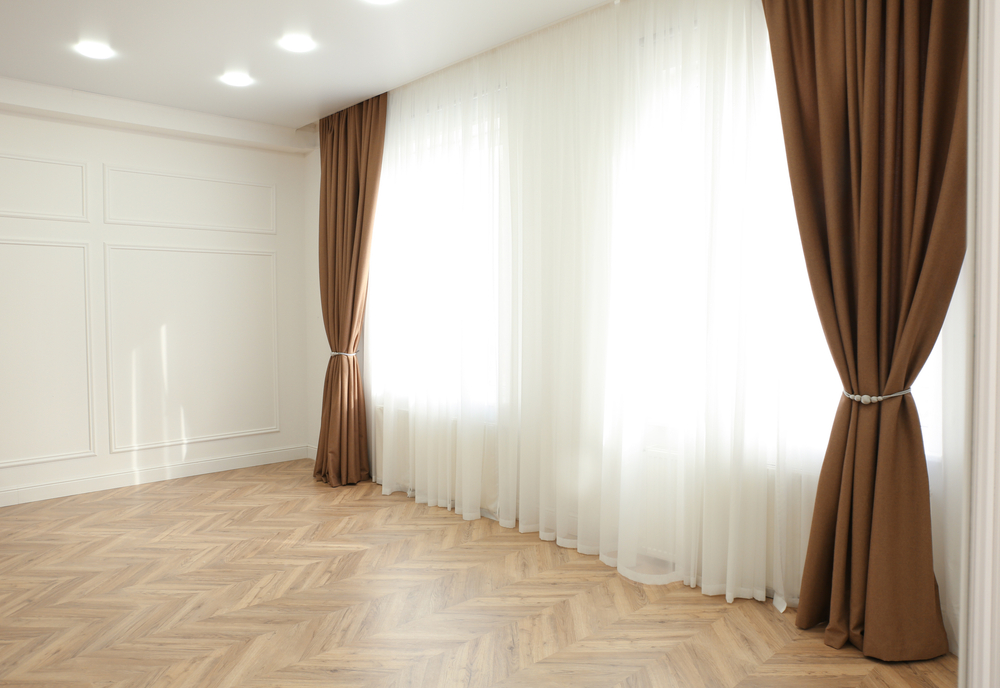In event planning and interior design, the art of drapery stands as a potent, transformative element. Whether it is a corporate event, a wedding, an exhibition, or any gathering under the sun, the selection of drape length can set the stage, alter moods, and orchestrate an unforgettable experience. As North America’s market leader in event rentals, Quest Events has long recognized the sheer power of the fall of the fabric. With a legacy steeped in creativity, efficiency, and excellence, Quest Events offers an exhaustive guide that unravels the mysteries behind selecting the perfect drape length.
Jump Links
- The Importance of Drape Length
- Proper Drape Measurements
- Choosing the Perfect Length for Your Space
- Tips for Selecting and Installing Drape
- Conclusion
The Importance of Drape Length
Drape length is often likened to the spine of an event’s aesthetics. It measures not just in feet and inches but in ambiance and style. The cascade of fabric drape can create illusions of space, height, and grandeur. They can make a small room feel cozy or a large hall intimate. Essentially, the drape’s length becomes the language a space communicates.
Embarking on a Journey of Aesthetics
As we step into the world of drape lengths, we must recognize that this journey is equal parts science and art. The science lies in the precision of measurements, understanding the room’s dimensions, and selecting the appropriate fabric. The art is in interpreting the space, envisaging the event’s atmosphere, and breathing life into a setting through the drape.
A Tapestry of Choices
Draperies paint a tapestry as diverse as the events themselves. From the understated elegance of floor-length drape to the regal abundance of puddle-length, every choice weaves a different story. The designer’s or event planner’s vision, paired with the judicious selection of drape length, transforms a mere fabric into a tapestry that can adorn the halls of memories for every attendee.
Quest Events – Your Partner in Crafting Experiences
With an illustrious history in shaping events across many industries, Quest Events stands at the forefront of innovation in event rentals. Our deep understanding of the alchemy of space and décor is built upon years of dedication and an unwavering commitment to excellence. This guide, which we have carefully curated, is imbued with that essence and knowledge.
As we traverse through the pages of this guide, we will explore measurements, styles, fabrics, and much more. Each section will give you the insights and tools to select a drape and craft an experience. So, let us set sail on this voyage of creativity, where every fold and every inch of drape becomes a part of a more fantastic symphony.
The Importance of Drape Length
A drape’s length is akin to the strokes in a painting; it dictates the narrative. In event planning, the importance of drape length can’t be overstated, as it plays a multi-faceted role in the overall atmosphere and visual appeal.
Firstly, a drape’s length directly affects the visual perception of the space it occupies. For example, longer drape that extend from ceiling to floor can elongate the appearance of the walls, making a room feel taller and more spacious. This is particularly beneficial in venues with lower ceilings, where creating a sense of openness can make the space feel less constricted.
In contrast, a shorter drape can lend a more relaxed, intimate, or even informal ambiance to a space. This can be ideal for creating a cozy atmosphere focused on warmth and familiarity rather than grandeur.
Moreover, the length of the drape interacts with other design elements in the room. Elegant floor-length drape can frame large windows beautifully, accentuating natural light and views. Alternatively, a puddle-length drape can add a touch of luxury that enhances ornate pieces within the space, such as chandeliers or intricate moldings.
Another dimension of the importance of drape length is its role in functionality. In specific settings, the drape’s primary purpose is not just decoration but also insulation, light control, or privacy. For instance, a longer drape with a heavy fabric can provide better insulation, particularly useful in venues with drafts or large windows. Furthermore, for an event like a presentation or a cinema screening, you might opt for a floor-length blackout drape to control light efficiently.
Additionally, drape length contributes to the thematic expression of an event. A well-chosen drape length can resonate with the event’s theme and period. For example, a Great Gatsby-themed event might feature opulent puddle-length drape to evoke the extravagant roaring twenties. At the same time, a modern art exhibition might lean toward sharp, clean-lined floor-length drape for a minimalist aesthetic.
Lastly, drape length is a crucial component in the harmony of design. It helps achieve a balance between various elements. A drape should complement the windows, furniture, décor, and other textiles. A harmonious composition is pleasing to the eye and can enhance the event’s overall experience.
In summary, the length of a drape is a cornerstone in event décor. It’s an ambassador of style, functionality, and thematic expression. It can shape perceptions, evoke emotions, and even influence interactions within the space. It’s a testament to the adage that sometimes the beauty lies in the details. With meticulous consideration of drape length, you can elevate your event to a work of art.
Determining Personal Style and Preferences
Selecting the perfect drape length begins with comprehending your or your client’s style and preferences. Whether it’s the luxury of puddled drape or the streamlined aesthetic of floor-length drape, your choice should reflect the event’s theme, atmosphere, and personal taste.
Proper Drape Measurements
Choosing the ideal drape length hinges on precise measurements. Even a tiny miscalculation can lead to ill-fitting drape that detract from the overall design.
Measuring Window Size
Begin by measuring the window size. With a tape measure, determine the height from the top of the window to the floor and the width from one side of the window frame to the other. Measuring in at least three different spots for both dimensions is crucial to account for any variations.
Factoring in Rod’s Placement
Rod’s placement is critical. Typically, rods are positioned four to six inches above the window frame. Include these additional inches when measuring the height.
Taking Fabric Type into Consideration
The fabric type is pivotal to the final appearance of the drape. Heavy fabrics may require additional length as they tend to sag, while lighter materials might necessitate a slightly shorter length. Understanding how fabric behaves is essential for determining the correct size.
Common Drape Lengths
Having covered the measurement basics, let’s delve into the different types of drape lengths, each of which sets a distinct tone and ambiance for your event space.
Sill Length
Sill-length drape extends to the window sill, making a subtle yet definitive statement. Perfect for spaces where you wish to balance privacy and openness, these drape allow natural light to flood in while keeping the setting intimate. Ideal for casual or quaint environments, sill-length drape are frequently employed in cafes, kitchens, or spaces with a rustic or vintage theme. They evoke a sense of comfort and can be coupled with vibrant colors or patterns to add a dash of personality without overwhelming the space.
Apron Length
Dropping just below the window sill, typically by about four to six inches, an apron-length drape offers a slightly more polished look than sill-length. These drape are particularly suitable for spaces where longer drape are impractical, such as bathrooms or areas with heaters below the windows. They also work wonderfully in children’s rooms or spaces that require ease of movement. Apron-length drape can create a focal point above the sill, such as showcasing intricate woodwork or a stylish window frame.
Floor Length
Floor-length drape epitomize elegance. This drape either touches the floor or hovers slightly above it. Precision in measurement is critical here, as even a slight miscalculation can lead to an untidy appearance. These drape are incredibly versatile and have applications across many settings, from corporate events to weddings. They lend a neat, refined, and complete look, which can be tailored to formal or casual. For instance, a rich, heavy fabric in a dark color can create a dramatic and luxurious atmosphere, while a lighter fabric in a pastel shade can keep things airy and laid-back.
Puddle Length
For those looking to lavishly capture the essence of opulence and grandeur, puddle-length drape are the way to go. These drape extend onto the floor several inches to a foot, creating a sumptuous ‘puddle’ of fabric. This length is particularly favored in formal settings such as ballrooms, theaters, or lavish weddings. The excess fabric conveys a sense of indulgence and can make a bold statement. Consider using luxurious fabrics such as silk, velvet, or heavily embroidered materials when opting for a puddle-length drape. Moreover, they require regular maintenance to ensure the ‘puddle’ retains shape and doesn’t become a trip hazard.
Tailoring Drape Lengths to Different Styles
Understanding that these lengths can also be mixed and tailored to create unique styles is essential. For instance, pairing floor-length drape with shorter sill-length ones on either side can create depth and visual interest. Similarly, using tie-backs with puddle-length drape can add structure to the luxury.
Selecting the right drape length requires a harmonious blend of functionality, aesthetics, and the event’s character. Each size carries its own set of connotations and applications. Whether you’re looking to create a cozy, intimate setting with a sill-length drape, or a regal, awe-inspiring atmosphere with puddle-length ones, your choice will shape the experience and memories associated with the space.
Choosing the Perfect Length for Your Space
The selection of drape length should be context-driven.
Formal vs. Casual Settings
For formal settings like weddings or gala dinners, the dramatic effect of puddle length is often the preferred choice. Casual settings, like seminars or expos, usually opt for floor length for a more streamlined look.
Window Height and Room Proportions
Consider the window height and room proportions. For instance, a long drape can accentuate the height in a room with high ceilings, while a shorter drape might be more appropriate in a smaller space.
Drape Function and Purpose
Is the drape for privacy, controlling natural light, or purely decorative? The function often dictates the ideal length. For instance, drape meant to control light need to be longer and fuller.
Tips for Selecting and Installing Drape
Selecting the perfect drape is an art. Here are some tips to help you in this quest.
Purchasing Ready-Made vs. Custom Drape
Ready-made drape are convenient, but custom drape provide many options in fabric, design, and precise measurements.
Selecting the Right Hardware
Choosing the proper hardware, such as rods and hooks, is as important as selecting the drape. Make sure they complement each other and the overall design.
Proper Drape Installation Techniques
Selecting the ideal drape length is merely half the battle; the installation is where your vision comes to life. Proper installation techniques ensure the drape hangs beautifully and functions flawlessly. Here are some crucial points to consider.
Precision in Hanging
Precision is essential in drape installation. Before hanging, double-check the measurements of the drape and the space it will occupy. Make sure that the drape rods are level and at the correct height. An uneven rod will result in an asymmetric drape, which can destroy the entire aesthetic.
Fabric Preparation
Before installing the drape, ensure the fabric is in optimal condition. This includes steaming or ironing out any wrinkles and checking for loose threads or imperfections. For particularly long drape, having a second person assist with fabric handling may be helpful.
Mounting the Brackets
Securely mounting the brackets that will hold the drape rod is crucial. Use a stud finder to attach the brackets to the sturdiest points on the wall. If the drape is heavy, use anchors to fasten the brackets securely.
Managing Drape Fullness
How the drape fabric gathers along the rod, also known as fullness, affects the drape’s overall appearance. Typically, a fullness of 50% to 100% is recommended, but this can vary depending on the event’s theme and the fabric type. For a more opulent look, a higher fullness is preferable. In contrast, a more contemporary, minimalist setting might call for less fullness.
Securing the Drape
When hanging the drape, attach the fabric securely to the rod, ensuring even spacing between the hooks or rings. This will allow for even distribution of the fabric. Additionally, for taller installations, use a sturdy ladder or a lift. Safety should always be a priority.
Fine-tuning On-Site
Once the drape is hung, please step back and assess it from different angles and distances. Make sure it’s level and the fabric is evenly distributed. Don’t hesitate to make minor adjustments to perfect its appearance.
In conclusion, proper drape installation requires a balance of precision, aesthetic judgment, and safety. When executed flawlessly, the drape will be visually stunning and serve its function seamlessly. Whether working with opulent velvet for a gala event or light, airy fabrics for a casual gathering, how the drape is installed is integral to realizing your vision for the space.
Conclusion
Making a Statement with Drape Length
Drape length is more than just a measurement; it expresses style and purpose. The right drape length can make a powerful statement and transform a space.
Adapting to Changing Tastes and Trends
As trends evolve, so does drape styling. Being flexible and adaptive is vital. Whether you’re dressing a grand ballroom or a corporate seminar, Quest Events is your partner in achieving the pinnacle of creativity and sophistication through the perfect drape lengths.


